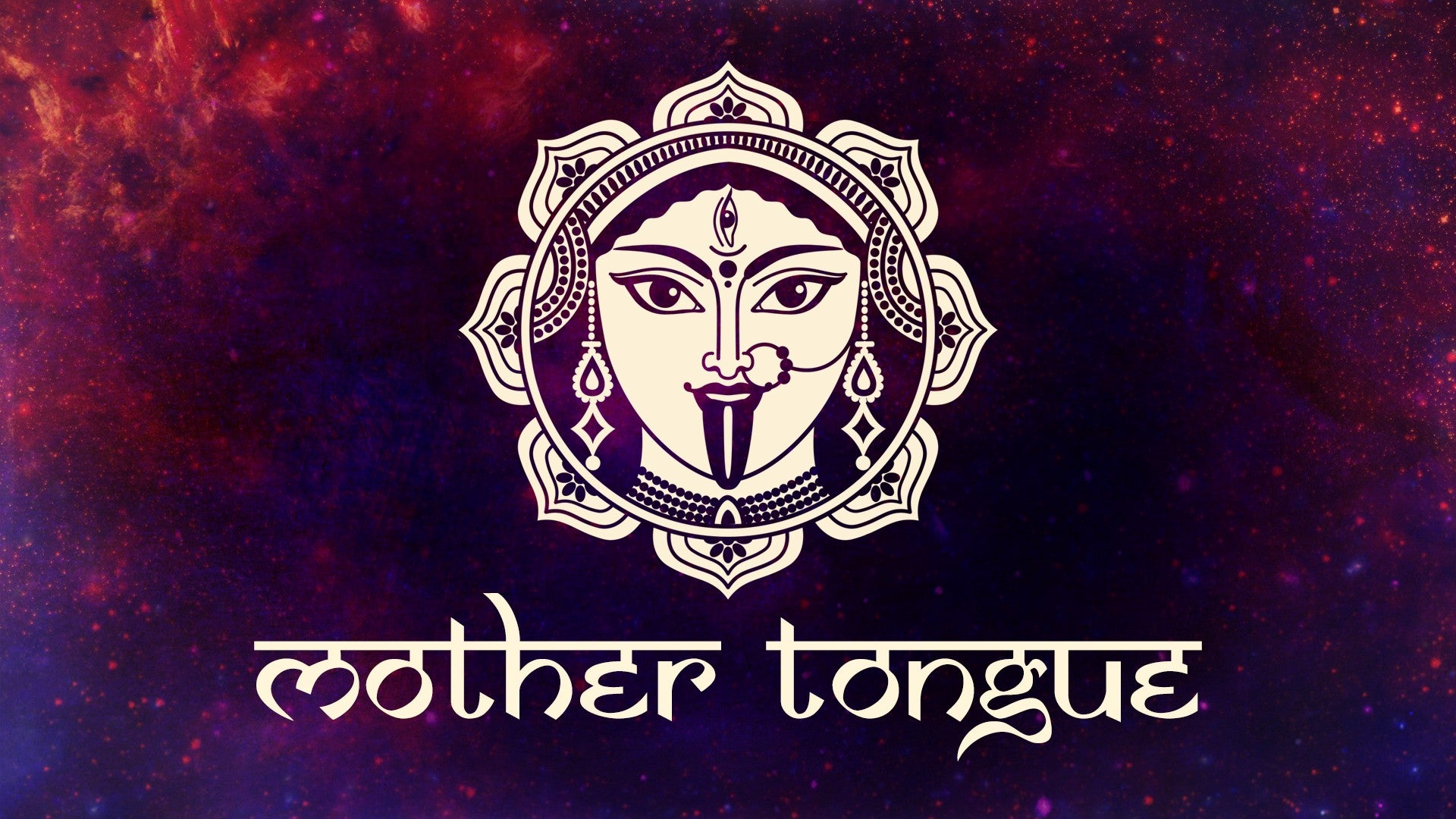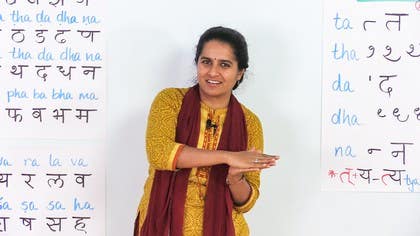Description
About This Video
Transcript
Read Full Transcript
Namaste friends welcome back again hope you've been practicing these letters regularly and that you're gaining some degree of mastery with them. If you stick with them daily just pick up one letter a day and I can assure you it will come really easy okay. So we have been looking at the guttural, the palatrals and the cerebrals which correspond to the throat, the palate, the cerebral and now we move on to the dentals. Like with the cerebral series the dental series is also very important because they are a set of sounds that don't form part of the English language. The English phonetic structure does not have these sounds and therefore there is a need to pay a little more attention to it. It can make a world of difference to the overall sound that you produce of any word. So we have an important word like shanti. In English you would tend to pronounce it more like shanti. The original sound is shanti. You say it and you will know the difference and when you know the difference you will feel how it changes things inside you and you will start beginning to appreciate the need for the correct pronunciation yeah. So we have the five sounds in this group which is the the and you can get it by gently placing the tip of your tongue behind the back of your front teeth the to exaggerate you can even stick it out a little maybe so the lovely the the second letter has the breath in it or the Maha Prana the third one is the voiced or where the sound comes first the and then you add a breath to that and then the nasal nna. In the transliteration you would notice that there is no dot or any extra sound to it and I think that is what also causes the confusion when one is pronouncing these words and you see it written in the Roman alphabet because there is nothing to indicate to an English-speaking person that the sound might be a little different. So when you have to do it with the dot below it then it is a cerebral and when you have it without anything it's the dental the the English term comes somewhere in between these two it's that where the tip of the tongue presses almost behind the teeth and the connection with the upper palate okay that's where it is so this one is the softer now that you're familiar a little bit with what it looks like let's try and write it out and what I will do is take you stroke by stroke through every letter so that you know exactly how it progresses and the rule in Sanskrit is that you always move from left to right so now we will see the five dentals by the way the Sanskrit word for dental is Danta many of the same sounds appear there so Danta and all the letters in that group very interestingly are from this the group of the dentals itself so we have the yeah that's quite fascinating so now we move on to the first letter which is the the the transliteration of that is the the the phoneme the plus the phoneme a or the vowel gives the if you have to write it step by step so the two and then you put a stick there preferably the line should cover the whole letter so just make sure you've got that so one two sometimes if it's more comfortable you can even start from there so you do one and then two okay the next one is the the breath the transliteration is with the H we have the the this is quite a beautiful letter actually so you start with a small round and almost like you were going to write a 2 second step is this and you make a small wave like that so it's a bit like a 2 really a stylish 2 the third step is this all the way through a T and a line now what I'd like to draw your attention to is that for the letter there there is no line that grows across like for all the other letters you have to leave a slight gap there and the reason for that is that it is very similar to the letter here see the letter here and the letter there they're very similar so the way that they are distinguished is that you have the small round on the tip and that the line doesn't go all the way through okay you remember that so the first combination of this type of letter is like a 2 with a rounded tip and no line right across and it corresponds to the say that very good we move on to the next letter which is the okay say that the and in Sanskrit or in the Devanagari script you start with one line which is actually this thing on top okay it's just that small line on top there so you do one and then you make a half tomato and with a tail that's what it is so the is quite similar to the D but it is the half tomato with the baby tomato and the tail so there is a certain precision there if you don't put the tail in it will end up being the D which is a different sound from the and if you put the tail in and you want a D you get a different sound so there are certain details that you need to pay attention to as you learn to write this script but take your time there really is no hurry in India we think that you know it's not just one lifetime we have various lifetimes and Sanskrit sometimes can take a while but if you love it and you apply yourself to it it will come to you like that open your heart that's the secret open your heart and practice as they say in yoga you need the abhyasa without abhyasa nothing gets done so that's the the line then half tomato with a tail the the following letter is the the and it looks like that you have a sleeping three which starts with a little round one two and three now you will notice that this letter also the line doesn't go all the way across like in the third and that's because it resembles another letter that we've already seen in the guttural group you have the letter her and you have the letter her you see this one doesn't have the rounded tip nor does it have the line right this one has the line right across it doesn't have the rounded tip here you have the rounded tip but the line doesn't go all the way across so one way you can try and remember it is that this is more a funny way of trying to remember it but it comes in the dental series and you get two sets of teeth and there's a gap in between so you can just remember that the ones where there is a breath have that gap in between the line doesn't go all the way through so you have the a very useful or rather this is a very commonly occurring sound in the yoga tradition and many Sanskrit words the next one we have is the nna the nasal nna and this is what it looks like nna so start with a small round and the line across one and then just put the T nna that is what it is nna got that now as we saw in the previous groups that these letters or the consonants when they are without the vowel can also sometimes combined with other consonants when they come in relation with other consonants there is a slight change in the way that they are written very often they would correspond to what they look like but sometimes there is a marked difference and it's useful to know what they might appear to be so we have here we have here the third so when I come when the letter combines with another this is what it looks like so if you have two T's which is I will write it for you to make it simpler so if you have half a T that combines with a full T this results in something which is like that this first T becomes a line over the other T I'll write the transliteration as well so you know what I am saying so that's the T plus the T gives you the T and we have important words in the yoga tradition like Sattva I'll show it to you so we have the Sattva I will just write the transliteration so sir and I put that Sattva we have a word like Sattva which has this double T combination but it also has an added complication of the V which you find quite often in the Sanskrit language so Sattva I will see if I can do that for you so this also gets half and you add the V to it this whole combination together will give you a that's the Tva you see there is a double T and a V so the T and V Sattva I'll not complicate it too much for you but just for your general knowledge it's useful to see how it comes into the word itself the second one third when it combines with another consonant like the year will drop the stick so the general rule about consonants combining with others if they have something like a stick is that you just have to drop the stick and connect it to the next letter so you have the sound here which is the T and the year so this sound put together will give you the here got that so that is the here coming down to the D so the D has a few variations as we had seen in the group of the tomatoes or the cerebrals when you have the rounded bottom then the letter tends to get squashed up and allows the next sound to come under it I'll give you an example so we have the letter D when it combines with a D like in Buddha he to break up the sounds you have Buddha he or Buddha very often is pronounced as Buddha but that's not being very true to what that particular word is composed of phonetically it's composed of bu du duh so I'll just show you what it looks like so you have the duh which just gets a little smaller and then below that you add this entire letter duh you have to have the rounded tip there to indicate that it's the duh so this is the duh duh so that's what it is so in the word Buddha this is what it would look like you just have to add the boo in front of it and that'll get together there okay so we have the sound Buddha okay the next one is the sound duh the duh as you can see there is a stick so it just joins with the next letter the important word diana is from using this one so we have the half duh the stick drops and you have the year that gets attached with it in transliteration that would be here so when you're writing the word yeah no you just have to add that extra stick to that by the side and that will give you the yeah no we've already seen that with the vowel combining with the different consonants so that's where you get the here right we move on to the next one which is the no and now in the half no combines with another consonant now you can guess what happens you just have to make half the nerve and you add the consonant there yeah so that is your nya as in shunya you have to have the shu before and then it looks like that shunya so that's what it would look like the double the there is another combination possibility there I will see if I can just put it in there so that you can make the connection with the the okay connected to this sound here so we have the half the plus the year as in the word sat here so in satya you have half a and the year and the rule is followed so this line drops and it attaches itself to the next letter so the line drops off and it gets connected to the next letter here so that for you is the here as you can see with this little example that there are exceptions to the way these letters combine with other consonants so there is a bit of practice that is required but don't let that trouble you don't let that become a very very serious obstacle to your pursuit of Sanskrit just enjoy it if there's a new variation that comes just learn it up until you find the next there aren't too many usually but it's yeah can be sometimes troublesome so there we have now we've seen the letters the the the and as you write it out the the the the no I often recommend that you do these letters using your body feeling the energy move in your body so we have the letter the which is going from left to right so play with it so do the letter the and as you do it please don't mirror me make sure that you are doing it from your left to right because if you mirror me you will end up doing the letter backwards okay so just see close your eyes visualize the letter in your mind sound it and then represent it using your hands and the body feel this power feel what the third does to you psychologically it is also combined to the whole concept of support and movement because the cerebral group as well as the dental groups correspond to your legs when you connect them to the organs of the body to the parts of the body so in that you can see that the legs are there to support us and to move us so the third corresponds to the power of support it's the primary focus her is the power of support with an adaptation the is the power of movement the primary focus the is the power of movement with an adaptation and now represents the power of movement and articulation it is also the point of connection with the cosmic Vienna the life energy that moves through the limbs of the body and as well as with the Apana the downward movement of the air so enjoy learning these letters pay attention to the pronunciation of these sounds just soften the sound remember that when if you're from the English speaking part of the world you have to be careful that the tea that you're saying in Sanskrit might not work it has to the tongue has to either be pushed further back or it has to come further in front so just pay attention and see the world of difference that makes to your experience with Sanskrit sounds and mantras enjoy the journey Shubham astu may well-being be yours







You need to be a subscriber to post a comment.
Please Log In or Create an Account to start your free trial.